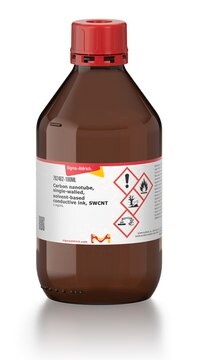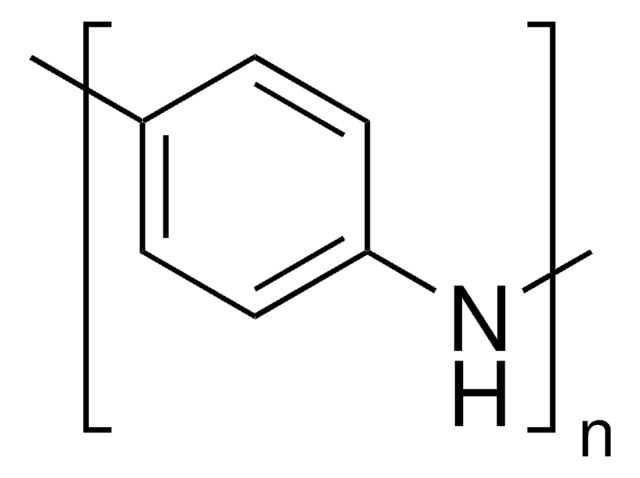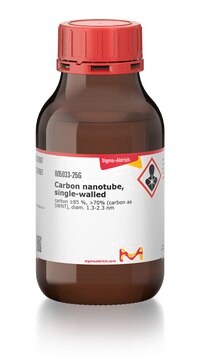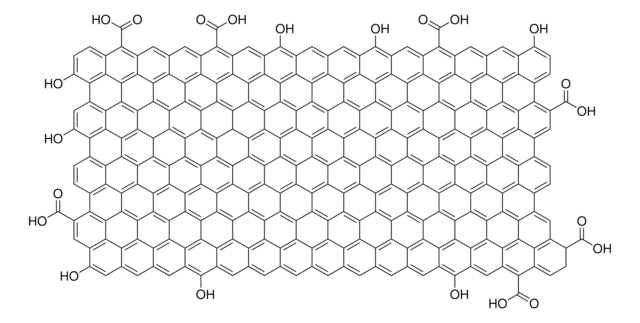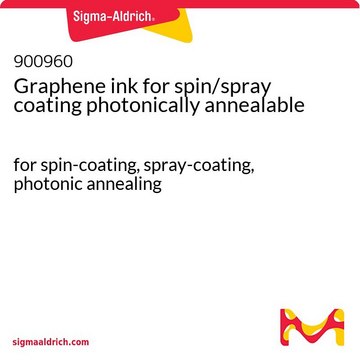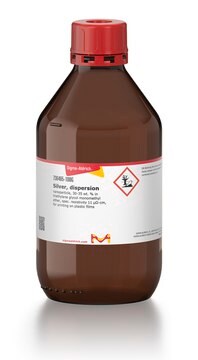791490
Carbon nanotube, single-walled
conductive aqueous ink, 0.2 mg/mL SWCNT
Synonym(e):
CG300-Aqueous Ink, SWCNT Ink, SWNT Ink, SWeNT AC100, Single-Walled Carbon Nanotube Ink
About This Item
Empfohlene Produkte
product name
Carbon nanotube, single-walled, conductive aqueous ink, SWCNT 0.2 mg/mL, avg. no. of layers, 1
Form
dispersion in H2O (black liquid)
Qualitätsniveau
Leistungsmerkmale
avg. no. of layers 1
Grünere Alternativprodukt-Eigenschaften
Design for Energy Efficiency
Learn more about the Principles of Green Chemistry.
sustainability
Greener Alternative Product
Konzentration
0.2 g/L (by Absorbance at 854 nm)
Widerstand
<400 Ω/sq (by 4-point probe on prepared film by spray)
Viskosität
~1.0 mPa.s
Dichte
1 g/cm3
Grünere Alternativprodukt-Kategorie
, Enabling
Allgemeine Beschreibung
Anwendung
This ink is primarily intended for making highly transparent conductive films on a variety of substrates.
Rechtliche Hinweise
Signis is a registered trademark of Chasm Advanced Materials, Inc.
CoMoCAT is a trademark of Chasm Advanced Materials, Inc.
CHASM is a trademark of Chasm Advanced Materials, Inc.
Lagerklassenschlüssel
12 - Non Combustible Liquids
WGK
WGK 1
Flammpunkt (°F)
Not applicable
Flammpunkt (°C)
Not applicable
Hier finden Sie alle aktuellen Versionen:
Analysenzertifikate (COA)
Die passende Version wird nicht angezeigt?
Wenn Sie eine bestimmte Version benötigen, können Sie anhand der Lot- oder Chargennummer nach einem spezifischen Zertifikat suchen.
Besitzen Sie dieses Produkt bereits?
In der Dokumentenbibliothek finden Sie die Dokumentation zu den Produkten, die Sie kürzlich erworben haben.
Kunden haben sich ebenfalls angesehen
Artikel
The emerging field of printed electronics requires a suite of functional materials for applications including flexible and large-area displays, radio frequency identification tags, portable energy harvesting and storage, biomedical and environmental sensor arrays,5,6 and logic circuits.
Boron nitride nanotubes (BNNT) are close structural analogs of carbon nanotubes (CNT), which are high aspect ratio nanotubular material, where carbon atoms are alternately substituted by nitrogen and boron atoms.
Professor Rivnay (Northwestern University, USA) discusses using organic mixed conductors as an alternative to efficiently bridge the ionic world of biology with contemporary microelectronics.
A nanocomposite is typically defined as a mixture between a host material (e.g., polymer matrix) and nanofillers with at least one dimension of less than 100 nm.
Unser Team von Wissenschaftlern verfügt über Erfahrung in allen Forschungsbereichen einschließlich Life Science, Materialwissenschaften, chemischer Synthese, Chromatographie, Analytik und vielen mehr..
Setzen Sie sich mit dem technischen Dienst in Verbindung.
